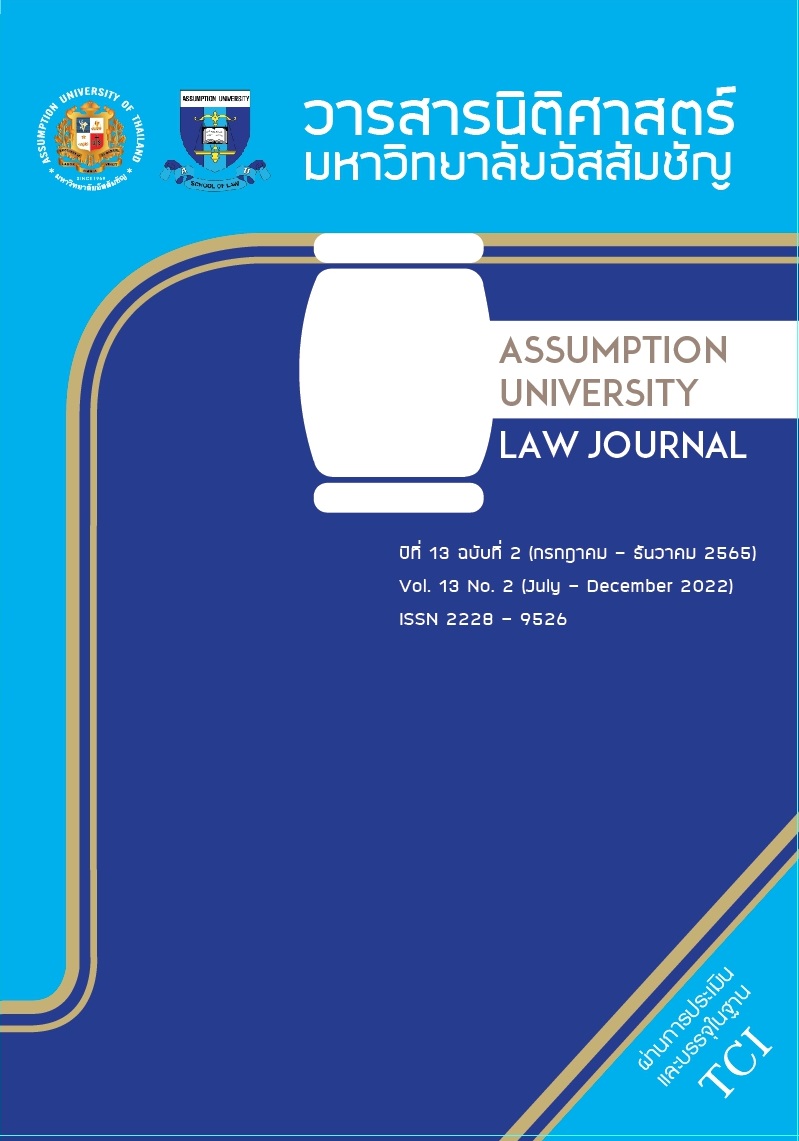การคุ้มครองลิขสิทธิ์การแสดงบัลเลต์: ศึกษาเฉพาะกรณี การเต้น classical ballet solo
Protection of Ballet in Realm of Copyright Law: Case Study of Classical Ballet Solo.
Keywords:
กฎหมายลิขสิทธิ์, การคุ้มครองท่าเต้นบัลเลต์, การแสดงบัลเลต์, Copyright Law, Protection of Ballet, BalletAbstract
บทคัดย่อ
บทความวิจัยนี้มีวัตถุประสงค์เพื่อ (1) เพื่อศึกษาวิวัฒนาการและการจาแนกหมวดหมู่โดยทั่วไปของท่าเต้นบัลเลต์ (2) เพื่อศึกษากฎหมายลิขสิทธิ์ที่เกี่ยวกับการดัดแปลงผลงานสร้างสรรค์ทางด้านนาฏยศิลป์ (3) เพื่อวิเคราะห์ความเป็นไปได้ในการออกแบบท่าเต้นที่ไม่มีส่วนสาคัญที่ซ้ากันเลย (4) เพื่อเสนอแนวทางในการให้ความคุ้มครองแก่งานนาฏยศิลป์ที่จะสามารถสอดคล้องกับสภาพความเป็นจริง การวิจัยครั้งนี้เป็นการวิจัยเชิงคุณภาพ โดยการรวบรวมข้อมูล วิเคราะห์เนื้อหาและสังเคราะห์เนื้อหาจากบทความ สารสนเทศบน Internet และการสัมภาษณ์เชิงลึกผู้ทรงคุณวุฒิทางด้านบัลเลต์ กลุ่มตัวอย่างเป็นการสุ่มแบบเจาะจง สัมภาษณ์ผู้ทรงคุณวุฒิที่มีประสบการณ์ทางด้านบัลเลต์มากกกว่า 10 ปี จานวน 6 ท่าน
ผลการวิจัยพบว่า (1) วิวัฒนาการของบัลเลต์ได้แพร่หลายจากอิตาลีไปทั่วทวีปยุโรป จากยุคกลาง ยุคเรอแนซซองค์ ก้าวสู่ยุคบัลเลต์คลาสสิกในรัสเซีย และการจาแนกหมวดหมู่โดยทั่วไปของท่าเต้นบัลเลต์มีชื่อโดยเฉพาะ เช่น Solo คือการแสดงเดี่ยว Duet คือการเต้นคู่ของเพศเดียวกัน Pas de Deux คือการเต้นคู่ของหญิงชาย เป็นต้น (2) กฎหมายลิขสิทธิ์ที่เกี่ยวข้องคือ พระราชบัญญัติลิขสิทธิ์ พ.ศ. 2537 หมวดที่ 1 ส่วนที่ 3 มาตรา 15 (3) เนื่องจากบัลเลต์ได้มีการกาหนดท่าพื้นฐานต่างๆ ไว้อยู่แล้ว ขึ้นอยู่กับผู้ออกแบบว่าจะนาท่าเหล่านั้นมาเรียงร้อยให้เกิดเป็นผลงานสร้างสรรค์ได้อย่างไร (4) สาหรับแนวทางในการให้ความคุ้มครอง ผู้สร้างสรรค์ควรจะกาหนดจุดที่เป็นสาระสาคัญของการแสดงที่สร้างขึ้นมาเอง สาระสาคัญที่ต้องการให้คุ้มครองคืออะไร และบัลเลต์ควรได้รับการคุ้มครองลิขสิทธิ์
Abstract
This article aimed (1) to study evolution and classification of choreography, (2) to study copyright law related to the adaptation of creative works in dramatic work, (3) to analyze the possibilities of choreography that do not have the same significant parts, (4) to propose guidelines for the protection of dramatic arts that can be consistent with reality. This research is qualitative research. Content analysis and content synthesis from articles, thesis, Internet and in-depth interviews. The population is ballet specialist. The samples were Purposive Selection from 6 people with more than 10 years of experience.
The result found as; (1) The evolution of ballet has spread from Italy throughout Europe, from the Middle Ages to the Renaissance, to Classical Ballet in Russia. The classification of choreography has specific names: Solo as performed by one person, Duet as a same-sex two people, Pas de Deux as a pair of male and female, etc. (2) The relevant copyright laws are Copyright Act B.E. 2537 Chapter 1 Part 3 Section 15 (3) Ballet has predetermined basic postures, depending on the choreographer how to arrange them into creative works. (4) The choreographer should determine the essence of the performance, which part want to protect and Ballet should be protected by copyright.
Downloads
Published
Issue
Section
License
- บทความทุกเรื่องได้รับการตรวจทางวิชาการโดยผู้ทรงคุณวุฒิ (Reader) จากภายในและนอกมหาวิทยาลัย
- ความคิดเห็นใดๆ ที่ลงตีพิมพ์ในวารสารกฎหมายคณะนิติศาสตร์ มหาวิทยาลัยอัสสัมชัญ เป็นของผู้เขียน (ความคิดเห็นใดๆ ของผู้เขียน กองบรรณาธิการวารสารกฎหมายคณะนิติศาสตร์ มหาวิทยาลัยอัสสัมชัญไม่จำเป็นต้องเห็นด้วย)
- กองบรรณาธิการวารสารกฎหมายคณะนิติศาสตร์ มหาวิทยาลัยอัสสัมชัญ ไม่สงวนสิทธิในการคัดลอก แต่ให้อ้างอิงแสดงแหล่งที่มาด้วย


